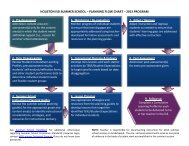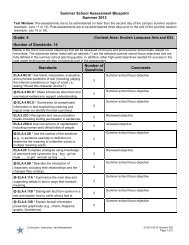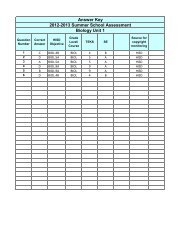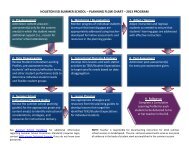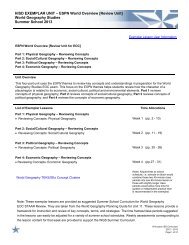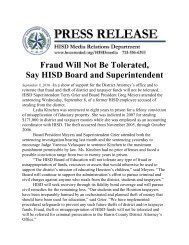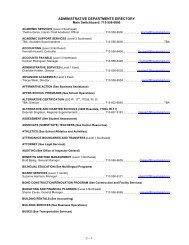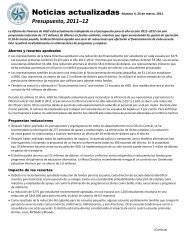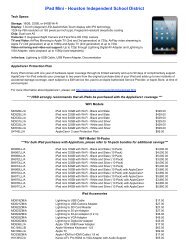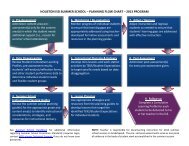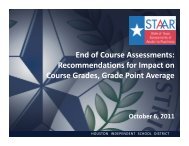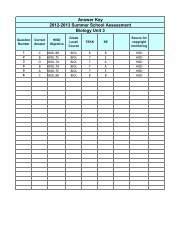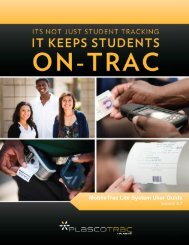SSK Unit 4.2 Planning Guide
SSK Unit 4.2 Planning Guide
SSK Unit 4.2 Planning Guide
- No tags were found...
Create successful ePaper yourself
Turn your PDF publications into a flip-book with our unique Google optimized e-Paper software.
Instructional ConsiderationsReadingHISD PLANNING GUIDEEnglish Language Arts Grade 7SUMMER SCHOOLPrerequisitesStudents should have prior knowledge relating to purposes for reading.Background Knowledge for TeacherThis unit examines expository texts. In preparation for building background knowledge, collect various types of articlesfrom newspapers, magazines, and the Internet. Consider the Lexile levels of students when selecting articles. Forsuggested texts, see Literature Grade 7 in Resources.Remind students that active readers begin by using prereading strategies, including previewing a text to set a purposefor reading and activate prior knowledge. (ELA.7.Fig19A)Use a mentor text to model connecting, visualizing, and questioning a text through a Think-Aloud. This methodillustrates the process a good reader goes through as they read. Be sure to use cues where appropriate. See ELA BestPractices MS in Resources.Review the various purposes for reading: To discover To be informedmodels for writing To be entertained To appreciate To take actionwriter’s craftFor more information on setting a purpose for reading, see Best Practices Toolkit in Resources. (ELA.7.Fig19A)Review the various types of author’s purposes. To inform To entertain To influence To expressIllustrate the link between reader’s purpose and author’s purpose. Have students create a graphic organizer to recordthe purposes of text. See Comparing Purposes in Instructional Strategies.Have students work in discussion groups to discuss and analyze texts. Discussion groups offer students a cooperativelearning environment to foster analysis and discussion. Remind students to record all learning in their LiteracyNotebooks. See ELA Best Practices MS in Resources.Remind students that active readers use strategies during reading to monitor their comprehension and to ‘fix’ anyproblems they encounter. Encourage students to become aware of reading difficulties. Provide students with a list ofcues to use when encountering difficulties in comprehension. See Comprehension Cues in Instructional Strategies.(ELA.7.Fig19C)Explain that informational texts can be magazine or newspaper articles, textbooks, directions, essays, or otherexpository or procedural pieces. For Reader’s Workshops on Reading for Information, see Literature Grade 7 andResource Manager Grade 7 in Resources.Introduce text features and provide examples in mentor texts. Focus instruction on utilizing the structures andorganizational aids to locate and organize information (in notes or in graphic representations) for recall, study, andfurther analysis. See Literature Grade 7 in Resources.Using mentor texts, illustrate that expository texts, particularly procedural texts, often include graphs, charts, pictures,and other graphic elements. These elements are referred to as graphical components. The graphical components in anexpository text present additional information to the audience. Therefore, students must be able to evaluate and tosynthesize the information. Provide a list of effective characteristics or a rubric for students to use as they evaluategraphics. Have students consider the following: What is the purpose of the graphic? Does the graphic provide useful information? What is the author saying through the graphic? - English Language Proficiency Standards (ELPS) - Literacy Leads the Way Best Practices - Aligned to Upcoming State Readiness Standard- State Process Standard R - State Readiness Standard S - State Supporting Standard© Houston ISD Curriculum2012 – 2013Page 4 of 12




